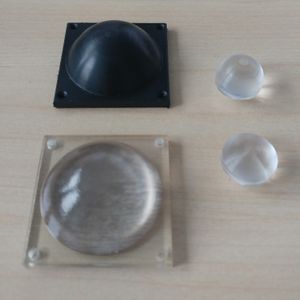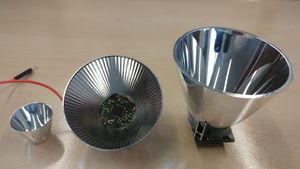Difference between revisions of "Lenses & Reflectors"
| (14 intermediate revisions by one other user not shown) | |||
| Line 2: | Line 2: | ||
__FORCETOC__ | __FORCETOC__ | ||
| − | = | + | = Lenses = |
| − | Any lens that works for other electromagnetic waves can work for radar, for example, LED lenses. Typically, lenses are made from a plastic or acrylic material and come in different sizes and forms. The size and form is important | + | Any lens that works for other electromagnetic waves can work for radar, for example, LED lenses. Typically, lenses are made from a plastic or acrylic material and come in different sizes and forms. The size and form is important to |
| − | + | * focus the beam - achieve a collecting or diffusing effect, | |
| + | * increase the gain of the signal (usually around 10 dB, maybe more), | ||
| + | * adapt the coupling into the air or other media. | ||
| − | Our evaluation kits have holes to mount | + | Our evaluation kits and some lenses already have holes to mount them. Other lenses might have to be glued to the front end or mounted in another way. If you need lenses, please contact our sales team. We also provide the lens data on request. Some lenses are shown in Figure 1. The standard black lens on the left for our evaluation kits is made from HDPE. The small lens on the right is a lathed acrylic lens. |
| + | |||
| + | {| | ||
| + | |[[File:Lenses.jpg|thumb|left|link={{filepath:{{PAGENAME:Media:Lenses.jpg}}}}|Figure 1: Different lenses]] | ||
| + | |} | ||
= Reflectors = | = Reflectors = | ||
| − | + | LED reflectors are very suited to be used for our radars. These reflectors can increase the gain of the signal more than lenses because any side lobes are redirected to the main viewing direction of the radar. We tested, for example, the following ranges (for big targets like buildings) in some quick experiments | |
| + | |||
| + | * 140 m with a reflector on the SiRad Simple (120 GHz), | ||
| + | * 200 m with a reflector on the SiRad Easy. | ||
| + | |||
| + | Typically, LED reflectors are made from a plastic material covered with metal and are available in different sizes. Bigger reflectors usually lead to higher gain. Reflectors mostly need to be glued to the radar (hot glue works just fine). However, care must be taken not to shortcut any signals on the radar with the metal cover of the reflector. We found the reflectors by TE Connectivity to be very suitable, for example, TE Connectivity 1-2154430-1, available from Mouser. | ||
| − | = | + | {| |
| + | |[[File:Reflectors.jpg|thumb|left|link={{filepath:{{PAGENAME:Media:Reflectors.jpg}}}}|Figure 2: Different reflectors]] | ||
| + | |} | ||
Latest revision as of 10:23, 8 December 2020
Contents
1 Lenses
Any lens that works for other electromagnetic waves can work for radar, for example, LED lenses. Typically, lenses are made from a plastic or acrylic material and come in different sizes and forms. The size and form is important to
- focus the beam - achieve a collecting or diffusing effect,
- increase the gain of the signal (usually around 10 dB, maybe more),
- adapt the coupling into the air or other media.
Our evaluation kits and some lenses already have holes to mount them. Other lenses might have to be glued to the front end or mounted in another way. If you need lenses, please contact our sales team. We also provide the lens data on request. Some lenses are shown in Figure 1. The standard black lens on the left for our evaluation kits is made from HDPE. The small lens on the right is a lathed acrylic lens.
2 Reflectors
LED reflectors are very suited to be used for our radars. These reflectors can increase the gain of the signal more than lenses because any side lobes are redirected to the main viewing direction of the radar. We tested, for example, the following ranges (for big targets like buildings) in some quick experiments
- 140 m with a reflector on the SiRad Simple (120 GHz),
- 200 m with a reflector on the SiRad Easy.
Typically, LED reflectors are made from a plastic material covered with metal and are available in different sizes. Bigger reflectors usually lead to higher gain. Reflectors mostly need to be glued to the radar (hot glue works just fine). However, care must be taken not to shortcut any signals on the radar with the metal cover of the reflector. We found the reflectors by TE Connectivity to be very suitable, for example, TE Connectivity 1-2154430-1, available from Mouser.

